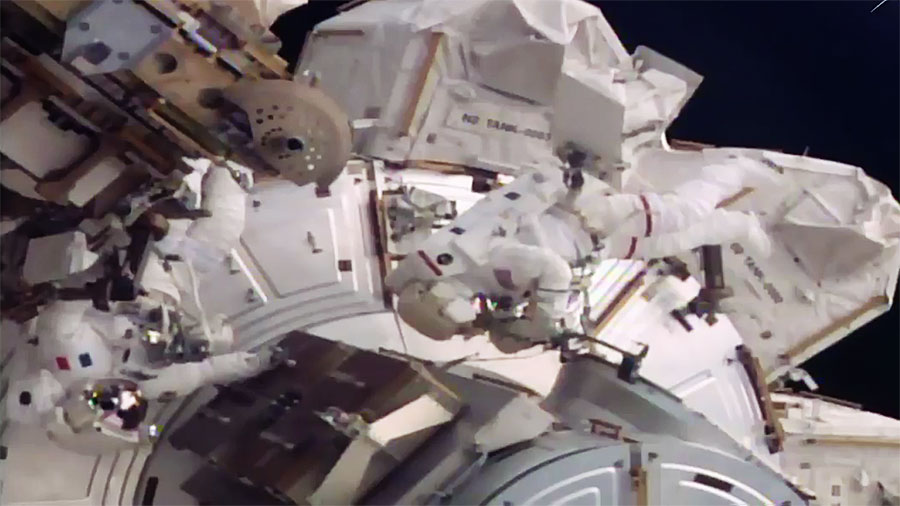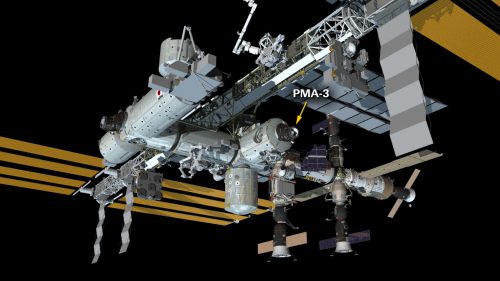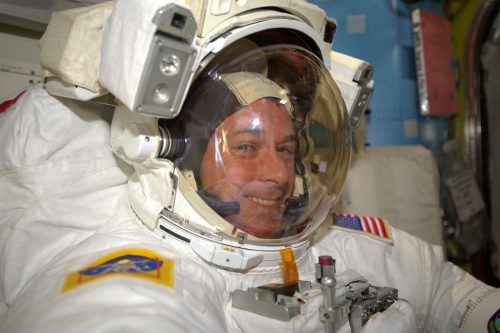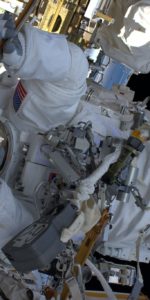
For the 40th time in a little more than 15 years, spacewalkers in U.S.-built Extravehicular Mobility Units (EMUs)—and without the presence of the Space Shuttle—departed the Quest airlock of the International Space Station (ISS), earlier today (Friday, 24 March). Expedition 50 Commander Shane Kimbrough and Flight Engineer Thomas Pesquet spent six hours and 34 minutes replacing hardware, lubricating the Latching End Effector (LEE) of the Dextre “hand” aboard the Canadarm2 robotic arm and preparing for the relocation of Pressurized Mating Adapter (PMA)-3. Designated “U.S. EVA-40”, it marked the fifth career spacewalk for Kimbrough and the second for Pesquet.
With Kimbrough designated “EV1”, with red stripes on the legs of his EMU for identification, and Pesquet (“EV2”) clad in a pure white suit, the spacewalkers awoke early Friday. Assisted by Expedition 50 crewmates Peggy Whitson and Oleg Novitsky, they undertook the standard protocols of 60 minutes of pre-breathing on masks, during which time the inner “equipment lock” of the Quest airlock was depressed from its ambient 14.7 psi to 10.2 psi. Kimbrough and Pesquet completed the purging of their EMUs by about 4:40 a.m. EDT, after which the airlock’s atmosphere was repressurized back up to 14.7 psi to enable them to head into a nominal pre-breathing regimen of about 50 minutes.
Next, the spacewalkers performed 50 minutes of In-Suit Light Exercise (ISLE). First trialed during the STS-134 shuttle mission in May 2011, ISLE serves to rapidly remove nitrogen from the bloodstream, thereby avoiding a potentially fatal attack of the “bends” and skirting the need for Kimbrough and Pesquet to camp out overnight inside Quest. At length, Whitson and Novitsky maneuvered the fully suited pair and their tools through the hatch from the inner equipment lock to the outer “crew lock” and sealed them off at 6:50 a.m. Depressurization of the crew lock commenced shortly afterwards, pausing briefly for pressure and leaks at 5 psi around 7 a.m., before decreasing to a condition of near-vacuum. At 7:24 a.m., Kimbrough and Pesquet transferred their suits’ critical life-support utilities from station power to internal battery power, officially kicking off U.S. EVA-40.

As its number implies, this was the 40th ISS-based spacewalk to be conducted in U.S. suits—and, crucially, without the presence of a docked Space Shuttle—in a little more than 15 years. Since U.S. EVA-1, performed by NASA astronauts Carl Walz and Dan Bursch, way back in February 2002, these so-called “Stage EVAs” have played a critical role in preparing the station for future expansion, as well as removing and replacing a failed ammonia pump module and a Main Bus Switching Unit (MBSU) and tending to ammonia leakages and the deterioration of several pieces of hardware. Most recently, in January, Kimbrough, Pesquet and Whitson supported U.S. EVAs 38 and 39 to replace aging nickel-hydrogen batteries with upgraded lithium-ion ones. Despite their “U.S.” nomenclature, these Stage EVAs have actually been performed by a mix of 25 NASA astronauts, together with spacewalkers from Russia, Germany, Japan, Italy and the United Kingdom.
With Kimbrough embarking on the fifth EVA of his astronaut career, and Pesquet becoming only the second Frenchman to perform multiple spacewalks, the opening minutes of EVA-40 were somewhat different. In order to provide Pesquet with hatch-opening experience, he was first out today, quickly followed by Kimbrough. They performed “buddy checks” of each other’s suits, before separating for what would turn out to be the majority of the EVA. Kimbrough’s main roles were to replace an Enhanced Processor & Integration Communications (EPIC) Multiplexer-Demultiplexer (MDM), disconnect cables from Pressurized Mating Adapter (PMA)-3—in readiness for its impending relocation from the Tranquility node to the Harmony node on Sunday, 26 March—and replace a pair of failed cameras on the Exposed Facility (EF) of Japan’s Kibo lab. Meanwhile, Pesquet’s tasks involved an inspection of a potential ammonia coolant leakage site and the lubrication of the Latching End Effector (LEE) aboard the Dextre robotic “hand” of Canadarm2.
The two veteran spacewalkers wasted little time and set to work moving to their respective work sites. Kimbrough headed along the airlock “spur” to reach the station’s central S-0 truss, where the two box-like External Multiplexer-Demultiplexers (EXT/MDMs) are situated. According to EVA-40 Spacewalk Officer Sarah Korona, speaking during a media briefing at the Johnson Space Center (JSC) in Houston, Texas, last Wednesday, there are no faults with the current External Multiplexer-Demultiplexers (EXT/MDMs), but they are being replaced with the Enhanced Processor & Integrated Communications (EPIC) MDMs as an upgrade. Kimbrough was tasked with replacing the first MDM during today’s spacewalk and will tackle its twin on U.S. EVA-41, next Thursday.
By 8 a.m. EDT, brandishing a Pistol Grip Tool (PGT) like a sharpshooter in the Old West, Kimbrough had already detached the old EXT/MDM and replaced it with the new EPIC MDM. The new units employ modern processing technologies, enhanced memory and ethernet cabling to provide a higher bandwidth and greater data download capacity for ISS experiments and research payloads.

In the meantime, Pesquet made his way directly to External Stowage Platform (ESP)-2, an 8.5-foot x 14-foot (2.6-meter x 4.3-meter) equipment pallet, which is attached to the Quest airlock. From here, he collected an Articulating Portable Foot Restraint (APFR), together with an “extender”, since his EVA-40 tasks would require additional reach. Pesquet’s first port of call was the station’s P-1 truss radiator, to inspect an area in the vicinity of one of the Radiator Valve Beam Modules (RVBMs) where a small rate of ammonia leakage has been recorded over the last year. After photographing the area, he checked flex hoses, the four fluid quick disconnects and rigid system lines, in order to bring what Expedition 50 Flight Director Emily Nelson called “human eyeballs” to bear on an area of the External Thermal Control System (ETCS) which may harbor an ammonia leak.
Working way ahead of the timeline, and with his EPIC MDM task complete, Kimbrough had translated to the far-port side of the space station and was in position at PMA-3 by 9 a.m. EDT. This conical docking adapter is one of the oldest components aboard the ISS—having been delivered by shuttle Discovery’s STS-92 crew, way back in October 2000—and has been moved on numerous occasions over the years. It currently resides on the port side of the Tranquility node, but on Sunday will be robotically detached via Canadarm2 and installed onto the space-facing (or “zenith”) port of the Harmony node. This will allow PMA-3 to receive International Docking Adapter (IDA)-3 in early 2018 and serve as a second docking port for Commercial Crew vehicles.
Kimbrough made short work of the PMA-3 task, disconnecting four cables and tying them down, preparatory to Sunday’s relocation. The latter will be conducted by the Robotics Officer (ROBO) in the Mission Control Center (MCC) and is expected to require limited interaction from the Expedition 50 crew. Remaining on the port side of the ISS, Kimbrough’s next call was the Exposed Facility (EF)—the large “porch”—of Japan’s Kibo lab. He was required to remove and replace a pair of failed camera/light units. The first was aboard Kibo’s robotic arm and was replaced and confirmed to be fully functional by 11:30 a.m. The second required Kimbrough to translate “beneath” the EF pallet, moving across its nadir face to the forward-facing side. All of this afforded Kimbrough spectacular and virtually unobstructed views of the entire port side of the U.S. Orbital Segment (USOS).
In the meantime, Pesquet labored with apparent ease through his inspection of the RVBM. Although no obvious instances of ammonia “flakes” were discerned, it is likely that this location will be revisited on a future EVA. Next, with the assistance of Peggy Whitson at the Canadarm2 controls, he set to work lubricating the LEE latches aboard Dextre. Similar LEE Lube work was previously undertaken by Expedition 42 spacewalker Terry Virts on Canadarm2 itself in February 2015, with Pesquet’s activity today focusing solely on Dextre, which was launched to the ISS aboard shuttle Endeavour in March 2008. Like Virts before him, Pesquet employed a Ballscrew Lubrication Tool (BLT) to apply grease to the ballscrews inside the LEE, which have degraded after nine years in orbit. By midday EDT, about 4.5 hours into EVA-40, Pesquet had lubricated all four LEE latches and applied grease to the linear bearing tracks.
Elsewhere, Kimbrough was wrapping up the installation of the new camera/light units aboard Kibo and later breezed through a get-ahead task of replacing a light on a Crew and Equipment Translation Aid (CETA) cart. Wrapping up their respective tasks, and cleaning up their respective work sites, the two spacewalkers then returned to the Quest airlock. Hatch closure and the conclusion of EVA-40 came at 1:58 p.m. EDT, after six hours and 34 minutes. As outlined previously by AmericaSpace, this is the first of three EVAs over the next two weeks, with the principal goal of reconfiguring PMA-3 from its current position on the Tranquility to its final Commercial Crew location on the Harmony node.
Be sure to “LIKE” AmericaSpace on Facebook and follow us on Instagram & Twitter!





